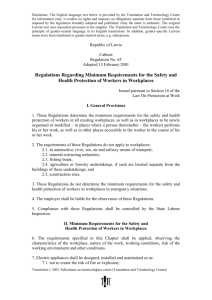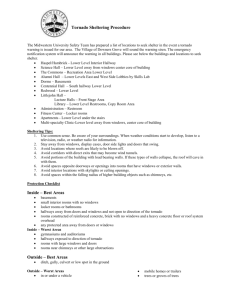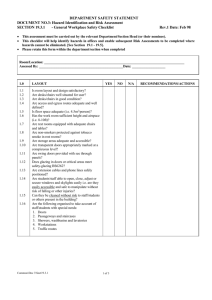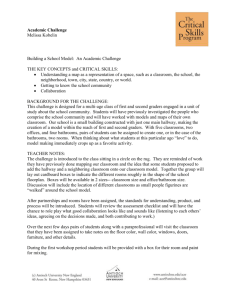Cab._Reg._No._125_
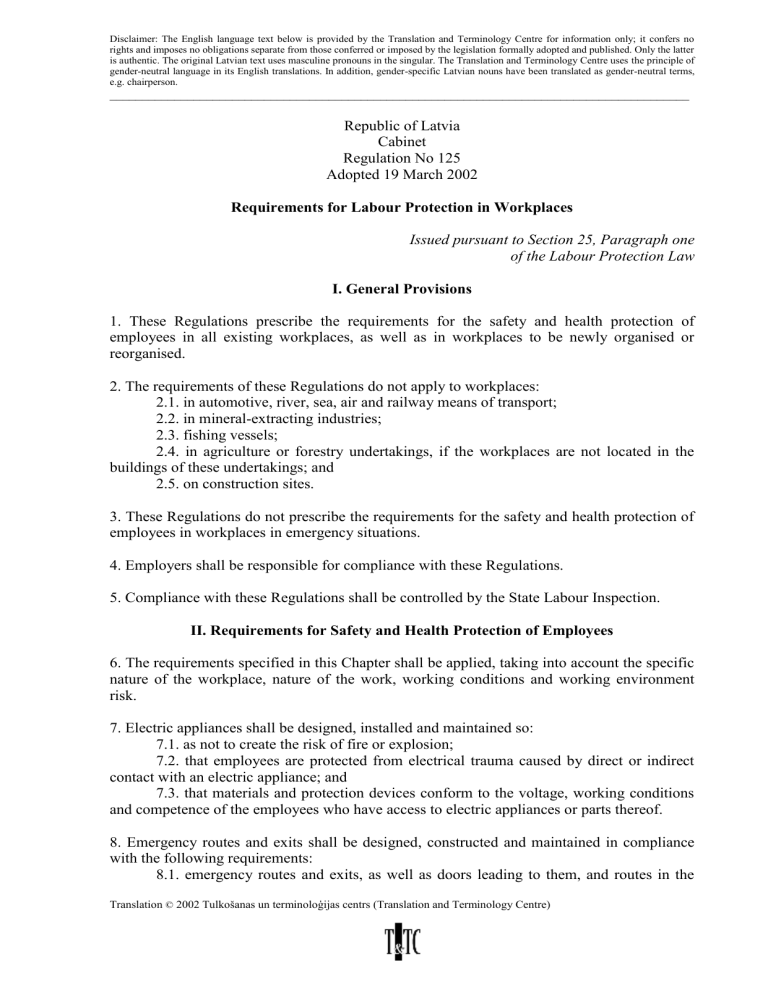
Disclaimer: The English language text below is provided by the Translation and Terminology Centre for information only; it confers no rights and imposes no obligations separate from those conferred or imposed by the legislation formally adopted and published. Only the latter is authentic. The original Latvian text uses masculine pronouns in the singular. The Translation and Terminology Centre uses the principle of gender-neutral language in its English translations. In addition, gender-specific Latvian nouns have been translated as gender-neutral terms, e.g. chairperson.
__________________________________________________________________________________________
Republic of Latvia
Cabinet
Regulation No 125
Adopted 19 March 2002
Requirements for Labour Protection in Workplaces
Issued pursuant to Section 25, Paragraph one of the Labour Protection Law
I. General Provisions
1. These Regulations prescribe the requirements for the safety and health protection of employees in all existing workplaces, as well as in workplaces to be newly organised or reorganised.
2. The requirements of these Regulations do not apply to workplaces:
2.1. in automotive, river, sea, air and railway means of transport;
2.2. in mineral-extracting industries;
2.3. fishing vessels;
2.4. in agriculture or forestry undertakings, if the workplaces are not located in the buildings of these undertakings; and
2.5. on construction sites.
3. These Regulations do not prescribe the requirements for the safety and health protection of employees in workplaces in emergency situations.
4. Employers shall be responsible for compliance with these Regulations.
5. Compliance with these Regulations shall be controlled by the State Labour Inspection.
II. Requirements for Safety and Health Protection of Employees
6. The requirements specified in this Chapter shall be applied, taking into account the specific nature of the workplace, nature of the work, working conditions and working environment risk.
7. Electric appliances shall be designed, installed and maintained so:
7.1. as not to create the risk of fire or explosion;
7.2. that employees are protected from electrical trauma caused by direct or indirect contact with an electric appliance; and
7.3. that materials and protection devices conform to the voltage, working conditions and competence of the employees who have access to electric appliances or parts thereof.
8. Emergency routes and exits shall be designed, constructed and maintained in compliance with the following requirements:
8.1. emergency routes and exits, as well as doors leading to them, and routes in the
Translation © 2002 Tulkošanas un terminoloģijas centrs (Translation and Terminology Centre)
territory of the undertaking (hereinafter - traffic routes) shall be clear so that a safe area may be reached as rapidly as possible;
8.2. emergency routes and exits shall ensure rapid and as safe as possible evacuation of employees from all workplaces in case of the threat of danger;
8.3. emergency doors shall open outwards;
8.4. emergency doors shall not be locked while employees are present, and shall be easily opened;
8.5. emergency routes and exit rooms shall be marked in accordance with the requirements for the use of safety signs at workplaces (inside);
8.6. the number, location and size of emergency routes and exits shall be determined depending on the number, equipment and size of the workplaces, as well as on the maximum potential number of employees; and
8.7. emergency routes and exits where illumination is necessary shall be equipped with emergency lighting of sufficient intensity.
9. Workplaces shall be provided with easily accessible, simple to use and suitable fireextinguishing installations (if possible - automatic), automatic fire-alarm systems, firedetectors, and fire-fighting devices in adequate quantities, taking into account the dimensions and purposes for utilisation of the building, work equipment, physical and chemical properties of the substances in use, and the maximum possible number of employees.
10. The equipment, systems and devices referred to in Paragraph 9 of these Regulations shall be regularly inspected and maintained in order, and location places thereof shall be indicated by signs which shall be placed in accordance with the procedures prescribed by regulatory enactments.
11. In planning, organising and maintaining a territory, the following requirements shall be complied with:
11.1. the territory shall be, if possible, planted with greenery, and shall have wellorganised traffic routes;
11.2. waste shall be collected, sorted and temporarily stored in specially organised places; and
11.3. warehouses for fine (powder-like) materials shall be located at a distance of least
25 metres from other buildings (if the size of the territory of the undertaking allows this).
12. Requirements regarding ventilation of enclosed workrooms:
12.1. a supply of fresh air shall be ensured, taking into account the nature of the work and the physical load of employees;
12.2. the concentration of substances which, upon coming into contact with a human body, may cause an injury, occupational disease or other health disturbances (hereinafter – harmful substance), may not exceed the maximum permissible concentration of harmful substances in the air of the working environment, which, during all working time of eighthour working days (or any other duration of exposure, but not more than 40 hours per week), does not cause contracting of a disease or health problems, which shall be determined by utilising the latest examination techniques (hereinafter – occupational exposure limit value for harmful substances);
12.3. air-conditioning or ventilation systems shall be maintained in good order, regularly cleaned and the efficiency of their operation inspected;
12.4. a ventilation control system which detects disturbances in the operation of the ventilation system shall be installed (if such a control system is necessary in order to ensure
Translation © 2002 Tulkošanas un terminoloģijas centrs (Translation and Terminology Centre) 2
the safety and health protection of employees in accordance with a decision of the employer or a request of the trusted representatives of the employees);
12.5. the operation of mechanical ventilation systems and air-conditioning equipment shall not cause draughts that exceed the permissible air movement rate;
12.6. in installing supply-exhaust ventilation and air heating, air re-circulation of not more than 90% of the total air supply volume shall be permitted. Air re-circulation from premises in which work involves chemical substances, chemical products, asbestos, bacteria, viruses, radioactive substances, as well as from premises in which work presenting a fire risk or an explosion risk is performed, is prohibited;
12.7. noise caused by ventilation and air heating devices shall not exceed the permissible noise level;
12.8. if, by utilising technical means, it is not possible to prevent or reduce the concentration of harmful substances to occupational exposure limit value for harmful substances, local exhaust ventilation shall be installed in the workplaces where harmful substances are discharged in the air so as to ensure that the harmful substances do not enter the respiratory organs of the employees, as well as neighbouring workplaces and the surrounding environment; and
12.9. ventilation system shall be connected with fire-alarm systems or fireextinguishing equipment, so that, in case of fire, the ventilation is switched off and the fire does not spread to other premises.
13. Production waste and chemical substances or chemical products that may pollute the air of the working environment or the atmosphere as a whole and pose a danger to the safety and health of the employees, shall be stored in conformity with the prescribed requirements or transported to appropriate dumps for hazardous waste.
14. Requirements regarding the microclimate of premises:
14.1. a microclimate (temperature, relative air humidity, air movement rate, reflected heat) that conforms to the nature of the work and the physical load of employees shall be ensured in the work rooms; and
14.2. in rest rooms, rooms for duty staff, changing rooms, lavatories, showers, canteens and first aid rooms a microclimate that conforms to the purposes for the utilisation of such rooms shall be ensured.
15. Requirements regarding the lighting of premises:
15.1. workplaces shall be provided with natural lighting and equipped with artificial lighting in such a way that the total lighting is sufficient for the safety and health of employees;
15.2. lighting devices in work rooms and passages shall be located so as to protect employees from risk of accidents and occupational diseases that are related to insufficient lighting; and
15.3. workplaces where harm to the safety and health of the employees may arise as a result of sudden switching off of light, shall be provided with sufficient emergency lighting.
16. Windows and skylights shall be designed, installed and maintained in compliance with the following requirements:
16.1. windows, skylights and glass partitions shall allow the avoidance of excessive effects of sunlight in workplaces, taking into account the specific nature of the work and the workplace;
16.2. employees shall have the possibility of opening, closing, adjusting or fixing
Translation © 2002 Tulkošanas un terminoloģijas centrs (Translation and Terminology Centre) 3
windows, skylights and ventilation openings in a safe manner;
16.3. open windows, skylights or ventilation openings shall not pose danger to the employees; and
16.4. windows and skylights shall be designed together with the equipment for their cleaning, or shall be fitted with devices that allow cleaning of them without exposing to risk the employees carrying out such work or who are present in the proximity of the windows.
17. Floors, walls, ceilings and roofs of the premises shall be designed, constructed and maintained in compliance with the following requirements:
17.1. the floors of the premises shall be stable, they may not be slippery or have dangerous bumps, holes or slopes that may endanger the safety and health of employees;
17.2. workplaces shall have sufficient thermal insulation, taking into account the nature of the work and the physical load of employees;
17.3. the floors, walls and ceilings in the premises shall be easy to clean and refurbish in conformity with the hygiene requirements;
17.4. transparent or translucent walls (in particular all-glass partitions in work rooms and in proximity to traffic routes) shall be clearly marked, made of safe material or demarcated in such a way as to prevent the employees from running into walls or injuries in case the walls shatter; and
17.5. measures shall be taken in order to prevent the performance of work on or access of employees to roofs that are made of insufficiently durable materials or may otherwise endanger the safety and health of employees (for example, not fenced off), unless such equipment is provided which allows carrying out the work in a safe manner.
18. Doors and gates shall be designed, constructed and maintained in compliance with the following requirements:
18.1. the location, number and dimensions of doors and gates, and the materials used therein, shall be determined by the specific nature and utilisation of the premises;
18.2. transparent doors shall be labelled at a conspicuous height;
18.3. revolving doors and gates shall be transparent or have translucent elements;
18.4. transparent or translucent parts in doors and gates, which parts are not made of durable material or may otherwise pose a risk of incurring injuries or traumas, shall be protected against breakage;
18.5. sliding doors shall be fitted with a safety device that prevents them from derailing and falling over;
18.6. doors and gates opening upwards shall be fitted with a mechanism that prevents such doors and gates from falling down;
18.7. doors opening to emergency routes and exits shall be marked with safety signs and can be opened from the inside at any time without assistance;
18.8. doors for pedestrians shall be installed in proximity to the gates intended for means of transport, if it is not possible to ensure the passage of pedestrians through such gates;
18.9. doors for pedestrians shall be clearly marked and unobstructed;
18.10. the operation of mechanical doors and gates shall not endanger employees, the doors and gates shall be fitted with easily noticeable and accessible emergency shut-down devices, which allow them to be opened if the doors and gates do not open automatically due to failure of the power supply;
18.11. gates intended for means of transport from the inside shall be marked with warning colours; and
18.12. emergency doors may not be sliding doors or revolving doors.
Translation © 2002 Tulkošanas un terminoloģijas centrs (Translation and Terminology Centre) 4
19. Traffic routes and areas in which the life or health of employees may be endangered
(hereinafter – danger area) shall be designed, organised and maintained in compliance with the following requirements:
19.1. traffic routes shall be located in such a manner as to ensure easy and safe access for pedestrians and means of transport to the routes, as well as not to pose danger to the employees working in proximity to such traffic routes;
19.2. pedestrian walkways and traffic routes shall conform to the maximum possible number of users;
19.3. if traffic routes are utilised both by means of transport and pedestrians, pedestrian walkways shall be installed or a safety clearance shall be left for pedestrians, ensuring also safe access to doors or gates, passages for pedestrians, corridors and staircases;
19.4. traffic routes shall be clearly indicated and marked;
19.5. if there are danger areas at workplaces where, due to the specific nature of the work, a risk exists for employees to fall or be injured by falling objects, such places shall be fitted with devices preventing unauthorised entrance of employees into such areas;
19.6. employees who work in danger areas shall be provided with collective or personal protective equipment; and
19.7. danger areas shall be clearly indicated and marked with safety signs in conformity with the requirements prescribed by regulatory enactments.
20. Workplaces shall be equipped with safe escalators and travelators that are fitted with safety devices, as well as with easily noticeable and accessible emergency shutdown devices.
21. Loading ramps and platforms shall be designed, constructed and maintained in compliance with the following requirements:
21.1. they shall conform to the dimensions and loading weight of the freight to be transported;
21.2. they shall have at least one exit point;
21.3. if technically possible, platforms exceeding the length specified in regulatory enactments shall have two exit points; and
21.4. they shall be equipped so as to protect employees from falling from them.
22. Work premises shall be designed, installed and maintained in compliance with the following requirements:
22.1. they shall be sufficiently spacious, high and with adequate air space; and
22.2. free and unused work room space at a workplace shall provide employees with sufficient freedom to move in order to perform their work, but if such is not possible due to the specific nature of the workplace, each employee shall be provided with sufficient freedom to move in the immediate proximity of his or her workplace.
23. Rest rooms shall be designed, constructed and maintained in compliance with the following requirements:
23.1. comfortable and accessible rest rooms shall be provided in conformity with the specific nature of the work and the number of employees;
23.2. they shall be sufficiently spacious and have a sufficient number of tables and seats with backrests;
23.3. if due to the specific nature of work frequent and regular breaks are necessary, but rest rooms have not been installed, there shall be other rooms in which employees can stay during breaks; and
Translation © 2002 Tulkošanas un terminoloģijas centrs (Translation and Terminology Centre) 5
23.4. requirements specified in this Paragraph need not be applied to offices or other workplaces having similar working conditions and where it is possible to rest equivalently during work breaks.
24. If pregnant women or women in the period following childbirth (up to one year) are employed, they shall be provided with a possibility to lie down and rest in suitable conditions in conformity with the hygiene requirements. For women who are breastfeeding the conditions referred to shall be ensured during the whole period of breastfeeding.
25. Changing rooms and lockers shall be designed, installed and maintained in compliance with the following requirements:
25.1. changing rooms shall be installed if wearing of special working clothes is intended in the work process or if such rooms are necessary for reasons of health or politeness;
25.2. changing rooms shall be easily accessible, sufficiently spacious, and equipped with seating and lockers;
25.3. separate changing-rooms shall be provided for men and women or, if such is not possible, separate use of changing rooms shall be ensured for men and women;
25.4. if working conditions are related to the exposure to harmful substances (for example humidity, dirt), storage of the employees' personal clothing and working clothes in separate lockers shall be provided;
25.5. air exchange or ventilation shall be provided in lockers for the employees' personal clothing and working clothes, if such is determined by the employer or the trusted representatives of employees; and
25.6. if changing rooms are not installed in accordance with Sub-paragraph 25.1 of these Regulations, each employee shall be provided with a separate (lockable) place for storage of his or her personal clothing and belongings.
26. Showers, washbasins and lavatories shall be designed, installed and maintained in compliance with the following requirements:
26.1. shower rooms shall be installed taking into account the nature of the work to be performed or if the installation has been determined by the employer or the trusted representatives of the employees. If possible, separate shower rooms for men and women shall be installed. If such is not possible, use of shower rooms shall be ensured separately for men and women;
26.2. shower rooms shall be sufficiently spacious so that they can be used in conformity with the hygiene requirements and without hindrance to others;
26.3. showers shall be equipped with a supply of hot and cold running water;
26.4. if shower rooms are not installed in accordance with Sub-paragraph 26.1 of these
Regulations, suitable washbasins with a supply of hot and cold running water shall be installed in the proximity of the workrooms and the changing rooms;
26.5. in cases referred to in Sub-paragraph 26.4 of these Regulations, if necessary, washbasins shall be demarcated or used separately by men and women;
26.6. if shower rooms or washbasins are installed separately from changing rooms, easy passage from one room into another shall be ensured;
26.7. the number of lavatories and washbasins shall be sufficient taking into account the number of employees. The relevant rooms shall be provided with the necessary personal hygiene products (toilet paper, soap, towels or devices for hand drying);
26.8. lavatories and washbasins shall be installed near workrooms and rest rooms, changing rooms and shower rooms;
Translation © 2002 Tulkošanas un terminoloģijas centrs (Translation and Terminology Centre) 6
26.9. lavatories and shower rooms shall be equipped with ventilation and the operation thereof shall be ensured; and
26.10. separate lavatories for men and women shall be installed or separate use thereof shall be ensured, as well as a separate cabin shall be installed for handicapped persons.
27. First aid rooms or places shall be designed, organised and maintained in compliance with the following requirements:
27.1. taking into account the type of activity, work load and working environment risk to the safety and health of employees, at least one or several first aid rooms that are fitted with first aid equipment and facilities shall be organised;
27.2. easy accessibility with stretchers shall be ensured to the rooms;
27.3. the rooms shall be clearly marked in conformity with the requirements regarding the use of safety signs at workplaces; and
27.4. first aid kits shall be available at all workplaces if it is necessary due to the working conditions, and the location of the first aid kits shall be marked with appropriate signs.
28. Workplaces outdoors shall be designed, organised and maintained in compliance with the following requirements:
28.1. workplaces, traffic routes and other areas or installations outdoors which are utilised in the course of work or where employees are present, shall be organised so that pedestrians and means of transport may move in a safe manner;
28.2. the requirements prescribed in Paragraphs 19, 20 and 21 of these Regulations also apply to traffic routes leading to specified workplaces and to routes utilised for the regular maintenance and supervision of installations and loading platforms;
28.3. the requirements prescribed in Paragraph 18 of these Regulations also apply to workplaces outdoors;
28.4. if necessary, workplaces outdoors shall be equipped with artificial lighting;
28.5. employees shall be protected against unfavourable weather conditions and from falling objects;
28.6. employees shall be provided with suitable protective equipment against slipping and falling;
28.7. employees shall have the possibility to rapidly leave workplaces in cases of accident or fire, or in other situations dangerous to health and life, and the rendering of first aid shall be ensured; and
28.8. employees shall not be exposed to noise that exceeds the maximum permissible level prescribed by regulatory enactments and to harmful external influences (for example, gases, vapours or dust).
29. In reconstruction and modernisation of workplaces the following requirements shall be complied with:
29.1. harmful substances, as far as possible, shall be replaced by harmless or less harmful substances;
29.2. concentration of harmful substances in the working environment shall not exceed the occupational exposure limit value for harmful substances;
29.3. the effects of working environment risk shall be reduced to the permissible and possible limits;
29.4. the physical load of employees shall be reduced as much as possible, and the principles of ergonomics shall be taken into account; and
29.5. working environment, if necessary, shall be adjusted for employees with special
Translation © 2002 Tulkošanas un terminoloģijas centrs (Translation and Terminology Centre) 7
needs (handicapped persons).
III. Obligations of Employers
30. For the safety and health of employees in workplaces, employers shall ensure:
30.1. unobstructed passages for pedestrians and means of transport so that emergency routes and exits may be reached, as quickly as possible, and unobstructed emergency routes and exits;
30.2. maintenance of work equipment in adequate technical order, as well as eliminate defects which negatively affect the safety and health of employees;
30.3. cleanliness in workplaces and regular cleaning of workplaces (in particular ventilation equipment), observing hygiene requirements and without posing threat to the safety and health of employees;
30.4. regular inspection and supervision of the operation of safety equipment and devices, which are intended for the reduction or prevention of the effects of such dangerous or harmful factors (chemical, biological, physical, psycho-physiological, technological and other), the effects of which cause (depending on the level and duration of exposure) occupational diseases, traumas, cause a loss of ability to work or a reduction in the ability to work;
30.5. regular informing of employees and their trusted representatives regarding all safety and health protection measures which are taken at workplaces;
30.6. consultations with employees and their trusted representatives, and their participation in the resolution of the issues related to the safety and health protection at workplaces;
30.7. training of employees regarding issues related to work safety and health protection; and
30.8. organising of workplaces (especially with respect to doors, stairs, emergency routes and exits, changing rooms, showers, washbasins, lavatories, rest rooms) so that, if necessary, persons with special needs (handicapped persons) may be employed.
IV. Closing Provision
31. Workplaces that have been established prior to the coming into force of these Regulations, shall by 31 December 2004 be modified in conformity with the requirements of these
Regulations.
Prime Minister
Minister for Welfare
A. Bērziņš
A. Požarnovs
Translation © 2002 Tulkošanas un terminoloģijas centrs (Translation and Terminology Centre) 8

